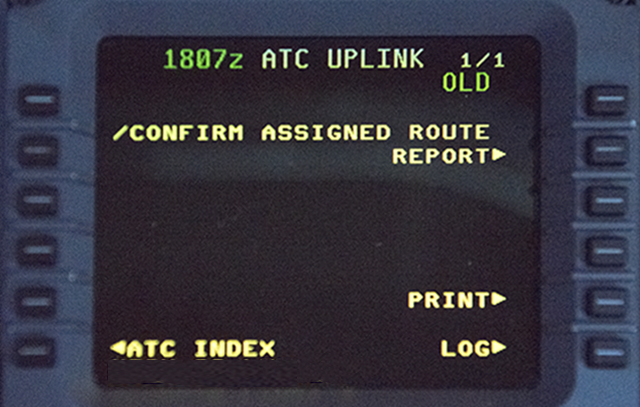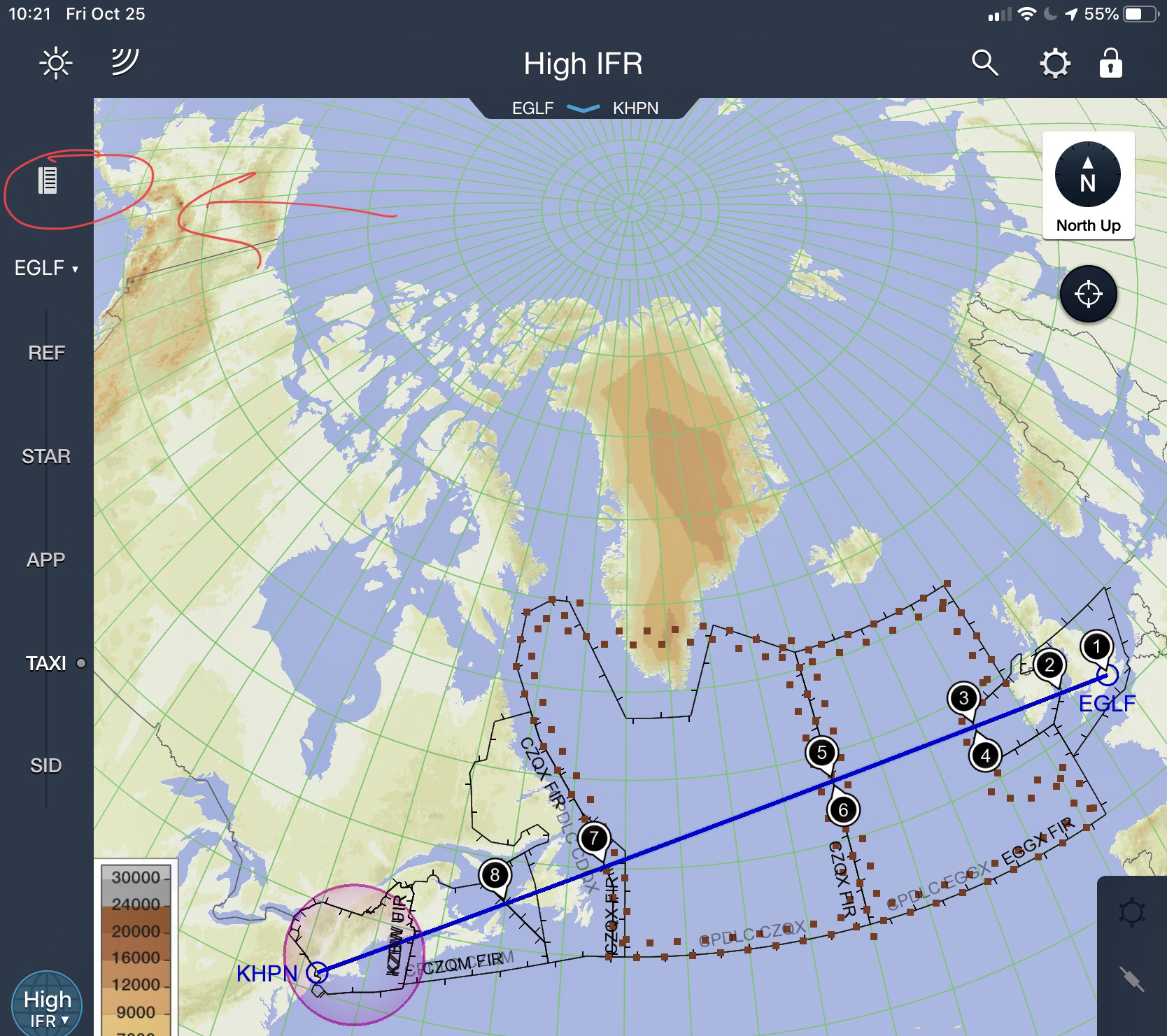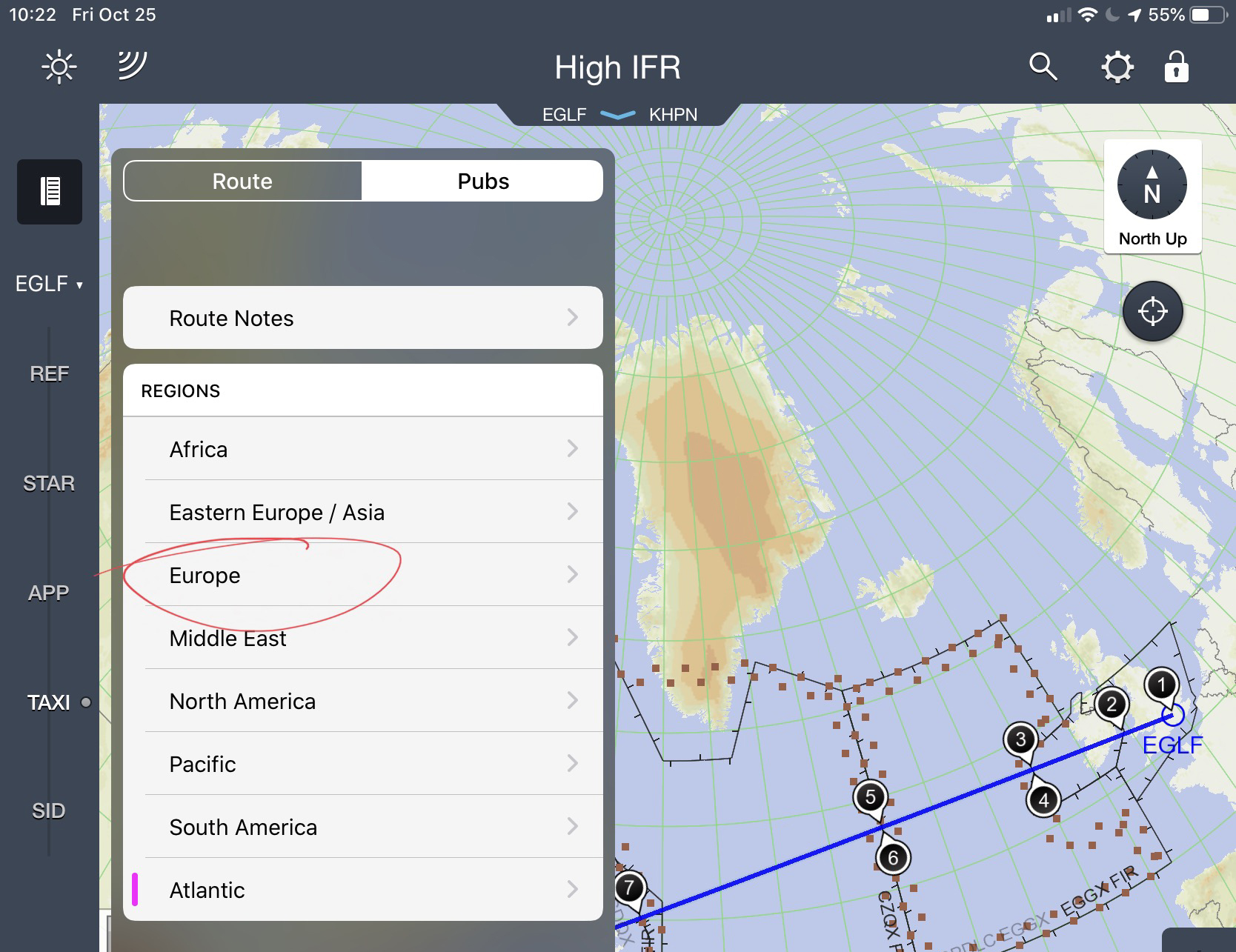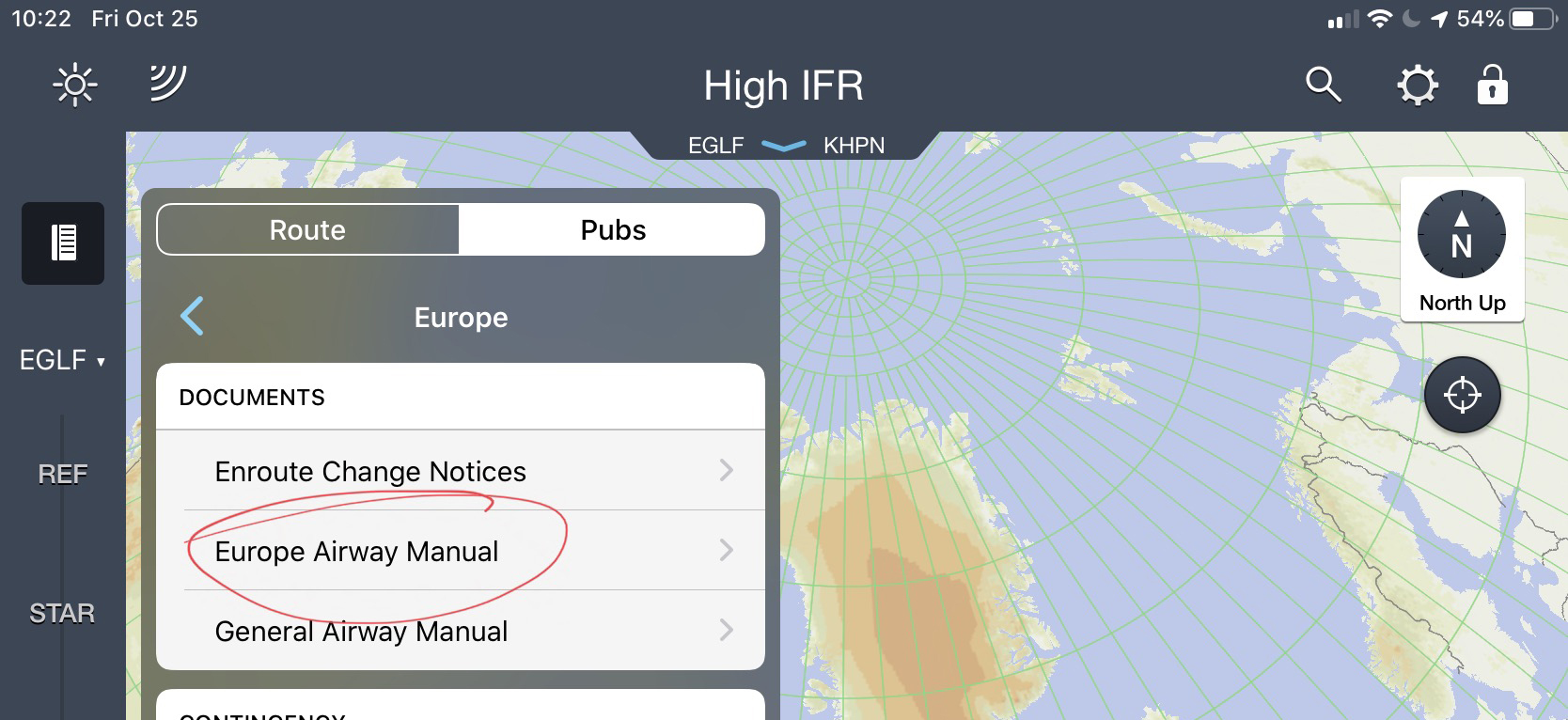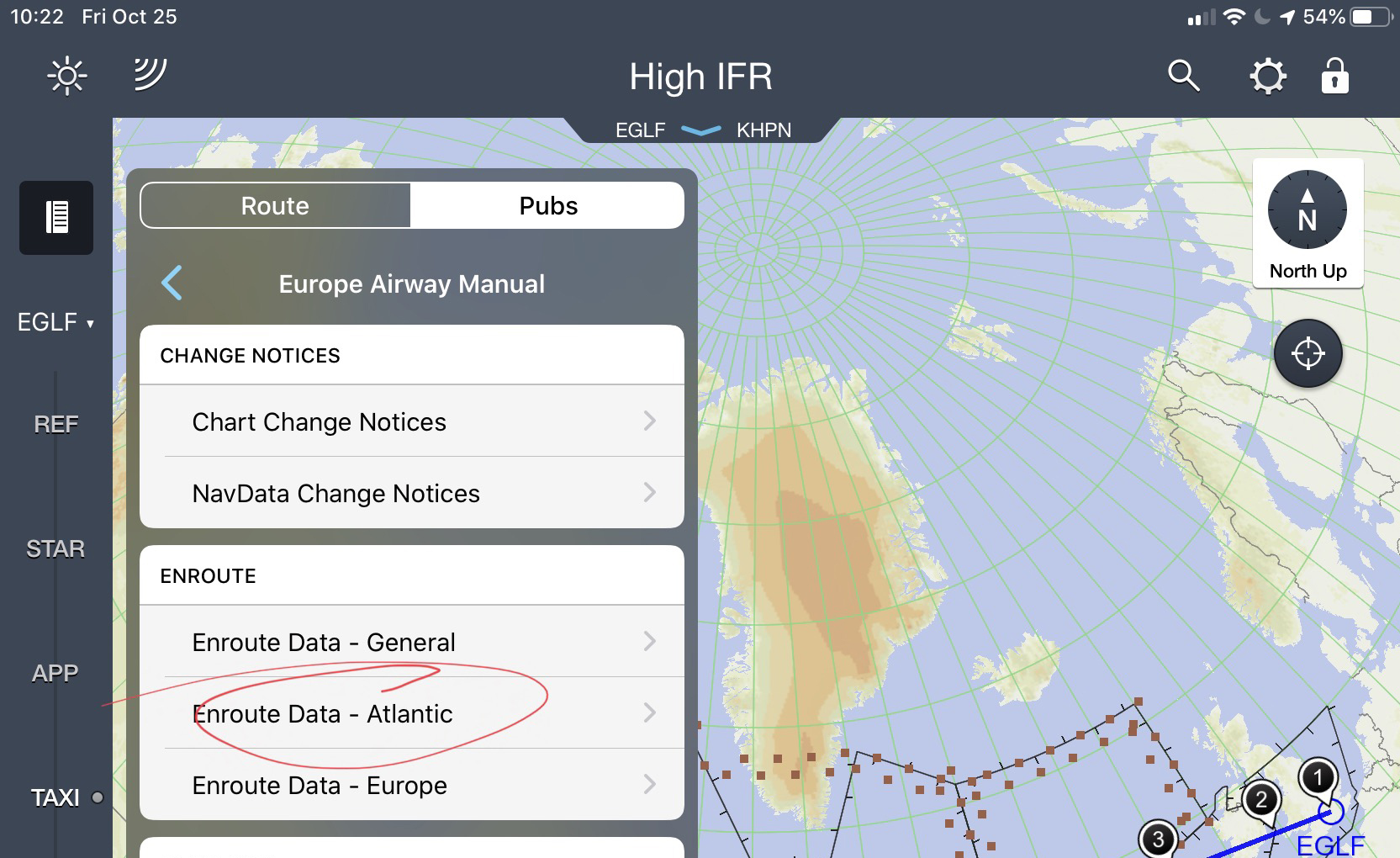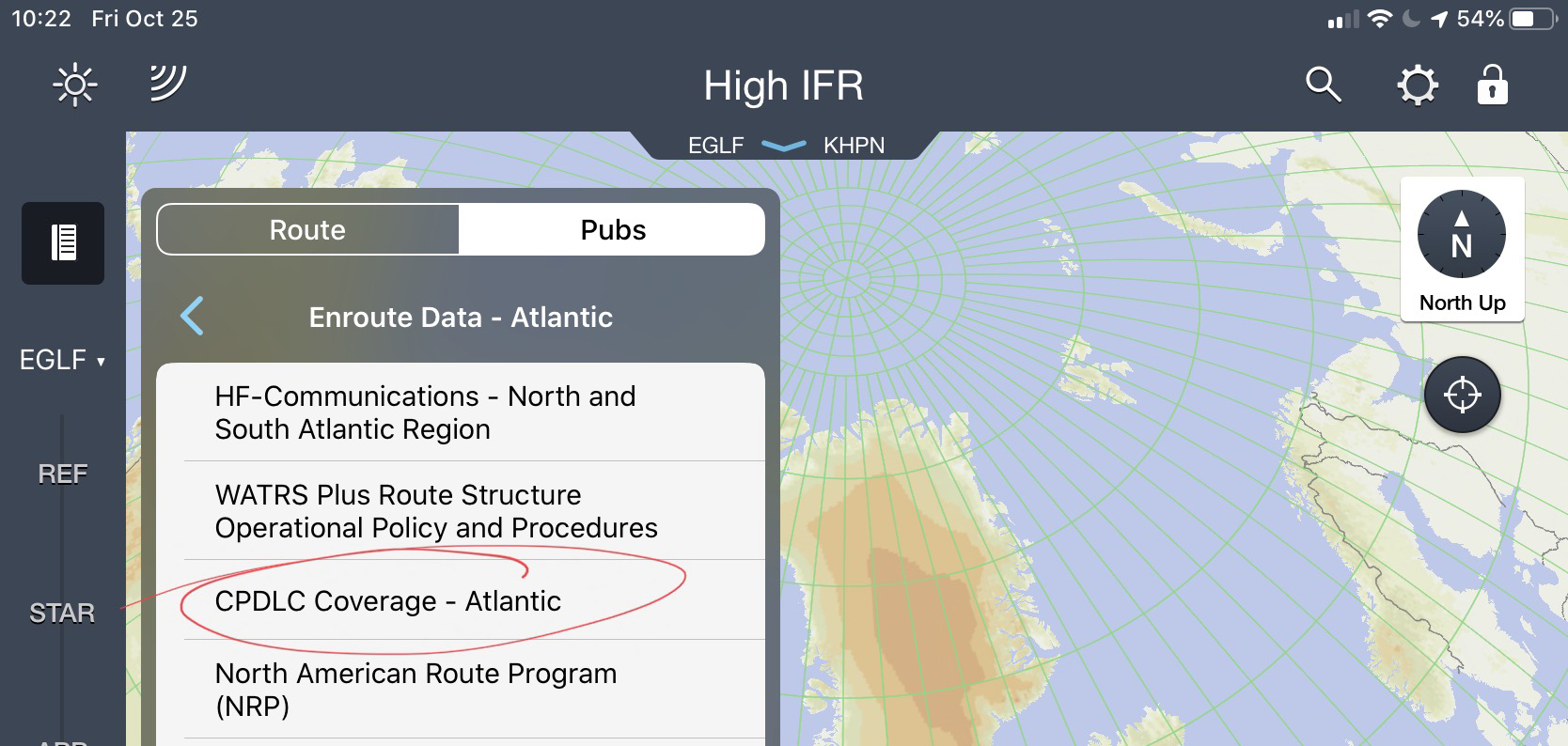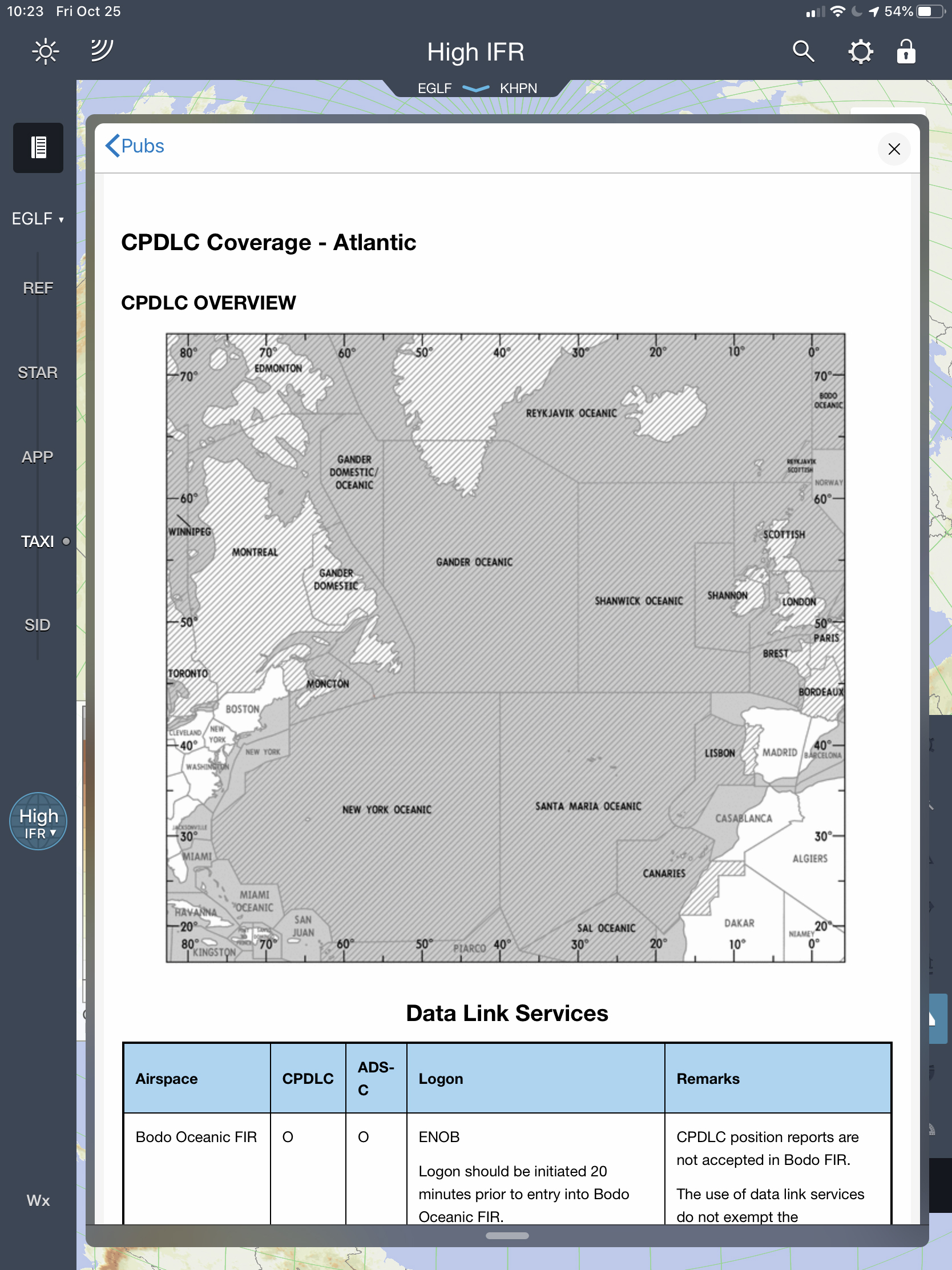You can think of Controller Pilot Data Link Communications as a replacement for your HF when oceanic and VHF over some domestic areas. It is far superior to your HF and has distinct advantages over VHF.
— James Albright

Updated:
2020-12-15
While it is optional for most of the world, CPDLC is becoming mandatory in some airspace.
2 — Operational differences between voice communications and CPDLC

1
Purpose
The role CPDLC plays in the Future Air Navigation System is to reduce the time it takes for air traffic control to issue instructions to a pilot and the pilot to acknowledge. In a domestic environment this is rarely a problem. When oceanic, however, it can be a factor. Reducing that time, known as Required Communications Performance (RCP), allows ATC to reduce aircraft spacing.
Lateral separation of aircraft on parallel or non-intersecting tracks or ATS routes. Within designated airspace or on designated routes, lateral separation between aircraft operating on parallel or non-intersecting tracks or ATS routes shall be established in accordance with the following:
- for a minimum spacing between tracks of 93 km (50 NM) a navigational performance of RNAV 10 (RNP 10), RNP 4 or RNP 2 shall be prescribed;
- for a minimum spacing between tracks of 42.6 km (23 NM) a navigational performance of RNP 4 or RNP 2 shall be prescribed. The communication system shall satisfy required communication performance 240 (RCP 240) and the surveillance system shall satisfy required surveillance performance 180 (RSP 180). Conformance monitoring shall be ensured by establishing an ADS-C event contract specifying a lateral deviation change event with a maximum of 5 NM threshold and a waypoint change event;
- for a minimum spacing between tracks of 27.8 km (15 NM) a navigational performance of RNP 2 or a GNSS equipage shall be prescribed. Direct controller-pilot VHF voice communication shall be maintained while such separation is applied;
- for a minimum spacing between tracks of 13 km (7 NM), applied while one aircraft climbs/descends through the level of another aircraft, a navigational performance of RNP 2 or a GNSS equipage shall be prescribed. Direct controller-pilot VHF voice communication shall be maintained while such separation is applied; and
- for a minimum spacing between tracks of 37 km (20 NM), applied while one aircraft climbs/descends through the level of another aircraft whilst using other types of communication than specified in d) above, a navigational performance of RNP 2 or a GNSS equipage shall be prescribed.
Source: ICAO Doc 4444, ¶5.4.1.2.1.6
You need CPDLC to begin the process of reducing separation standards. This is in your best interests, since the best routes — best winds, shortest distances — will be reserved for those able to fly with reduced separation.
2
Operational differences between voice communications and CPDLC
If you have CPDLC and you are in airspace where CPDLC is being used, you should use CPDLC as primary, voice communications as secondary. The general rule of thumb is: if contacted by CPDLC, respond with CPDLC; if contacted by voice, response with voice. When oceanic you still need to check in with HF, get a good SELCAL check, and maintain a listening watch if SELCAL fails.
- For example, when using voice communications, each flight crew member hears an incoming or outgoing ATS transmission. With voice, the natural ability for each flight crew member to understand incoming and outgoing transmissions for their own aircraft has provided a certain level of situational awareness among the flight crew. With CPDLC, flight crew procedures need to ensure that the flight crew has an equivalent level of situational awareness associated with understanding the content and intent of a message in the same way.
- Each flight crew member (e.g. pilot flying and pilot monitoring) should individually review each CPDLC uplink message prior to responding to and/or executing any clearance, and individually review each CPDLC downlink message prior to transmission. Reading a message individually is a key element to ensuring that each flight crew member does not infer any preconceived intent different from what is intended or appropriate. Reading the message aloud would bias the other flight crew member and could lead to the error of ‘reading’ what was read aloud as opposed to what was actually displayed.
- Some uplink messages, such as complex or conditional clearances, require special attention to prevent the flight crew from responding to a clearance with RSPD-1 WILCO, but not complying with that clearance. To minimize errors, when responding to a clearance with RSPD-1 WILCO, each flight crew member should read the uplink message individually (silently) before initiating a discussion about whether and how to act on the message.
- In a similar manner, each flight crew member should individually review CPDLC downlink messages before the message is sent. Having one flight crew member (e.g. the pilot monitoring) input the message and having a different flight crew member (pilot flying) review the message before it is sent provides an adequate level of situational awareness comparable to or better than voice communication.
- If an operator uses augmented crews, the flight crew carrying out the ‘handover’ briefing should thoroughly brief the ‘changeover’ flight crew or flight crew member on the status of ADS-C and CPDLC connections and messages, including a review of any pertinent uplink and downlink CPDLC messages (e.g. conditional clearances).
- The flight crew should coordinate uplink and downlink messages using the appropriate flight deck displays. Unless otherwise authorized, the flight crew should not use printer-based information to verify CPDLC messages as printers are not usually intended for this specific purpose.
Note.— For aircraft that have CPDLC message printing capabilities, there are constraints associated with the use of the flight deck printer. Printers may not produce an exact copy of the displayed clearance with the required reliability, and should not be used as the primary display for CPDLC. However, in some cases, printed copies may assist the flight crew with clearances and other information that are displayed on more than one page, conditional clearances and crew handover briefings.
Source: ICAO Doc 10037, ¶4.1.2.
- When operating within airspace beyond the range of DCPC VHF voice communication, CPDLC is available and local ATC procedures do not state otherwise, the flight crew should normally choose CPDLC as the means of communication. The flight crew would use voice as an alternative means of communication (e.g. VHF, HF or SATVOICE direct or via a radio operator). However, in any case, the flight crew will determine the appropriate communication medium to use at any given time.
- In airspace where both DCPC VHF voice and CPDLC communication services are provided, and local ATC procedures do not state otherwise, the flight crew will determine the communication medium to use at any given time.
- To minimize pilot head down time and potential distractions during critical phases of flight, the flight crew should use voice for ATC communications when operating below 10 000 ft AGL.
- While the CPDLC message set, as defined in Appendix A, generally provides message elements for common ATC communications, the flight crew may determine voice to be a more appropriate means depending on the circumstances (e.g. some types of non-routine communications).
- During an emergency, the flight crew would normally revert to voice communications. However, the flight crew may use CPDLC for emergency communications if it is either more expedient or if voice contact cannot be established.
- Except as provided in paragraph 4.6.1.2, the flight crew should respond to a CPDLC message via CPDLC, and should respond to a voice message via voice (ICAO Doc 4444 14.3.1.3 refers).
- If the intent of an uplink message is uncertain, the flight crew should respond to the uplink message with RSPD-2 UNABLE and obtain clarification using voice.
- Regardless of whether CPDLC is being used, the flight crew should continuously monitor VHF/HF/UHF emergency frequency. In addition, the flight crew should continuously maintain a listening or SELCAL watch on the specified backup or secondary frequency (frequencies).
Note.— ICAO Doc 4444, paragraph 8.3.2, requires that DCPC be established prior to the provision of ATS surveillance services, unless special circumstances, such as emergencies, dictate otherwise. This does not prevent the use of CPDLC for ATC communications, voice being immediately available for intervention and to address non-routine and time critical situations.
Note.— Refer to paragraph 4.6 for guidelines on use of voice and data communications in emergency and non-routine situations.
Note.— For ATN B1 aircraft, emergency message elements are not supported. See Appendix A, paragraph A 4.9 for a list of emergency message elements.
Note.— This will lessen the opportunity for messages to get lost, discarded or unanswered between the ATS unit and the flight crew and cause unintended consequences.
Note.— For FANS 1/A aircraft, some uplink messages do not have a DM 1 UNABLE response. On these aircraft, the flight crew should respond with DM 3 ROGER and then obtain clarification via voice.
Source: ICAO Doc 10037, ¶4.1.2.
3
Domestic CPDLC
Nomenclature
It may seem confusing, but you can begin to grasp the problem by understanding not all CPDLC is created equally:
- ACARS ATS — ATS applications, departure clearance (DCL), oceanic clearance (OCL) and data link – automatic terminal information service (D-ATIS), supported by aircraft communications addressing and reporting system (ACARS).
- FANS 1/A — Initial future air navigation system (FANS 1/A) ATS applications, AFN, CPDLC and ADS-C, supported by FANS 1/A over ACARS. Note.— FANS 1/A typically involve communication (CPDLC), navigation (RNAV/RNP) and surveillance (ADS-C). This document refers to the FANS 1/A for the data link system, which includes the CPDLC and ADS-C applications.
- FANS 1/A+ — Same as FANS 1/A, except with additional features, such as the message latency monitor function
- ATN B1 — ATS applications, CM and CPDLC, supported by aeronautical telecommunication network – baseline 1 (ATN B1): a) Context management (CM) application for data link initiation capability (DLIC); b) CPDLC for ATC communications management (ACM), ATC clearance (ACL), and ATC microphone check (AMC), except that: 1) CONFIRM ASSIGNED LEVEL and SYSU-5 USE OF LOGICAL ACKNOWLEDGEMENT PROHIBITED will not be used by the ATSU; and 2) ASSIGNED LEVEL (level) is not required by the aircraft.
- VDL M2 — Very high frequency data link – mode 2
Source: ICAO Doc 10037, Table 1-1.
- The ATN B1 data link system relies on the aeronautical telecommunication network (ATN), which is provided and maintained by various communication service providers (CSPs) and/or ANSPs.
- The ATN relies only on VHF (VDL M2) to meet the performance required for the intended operations.
Source: ICAO Doc 10037, ¶1.2.1.2.
So, how about all this in English?
- Most aircraft certified, equipped, maintained, and operated in the United States will have installed an older version of CPDLC called Future Air Navigation System (FANS 1/A) with Air Traffic Services (ATS) applications, ATC Facilities Notification (AFN), CPDLC and ADS-C.
- Many aircraft certified, equipped, maintained, and operated outside the United States recently, as well as many recently certified in the United States, will have installed a newer version of CPDLC that adheres to a newer standard called Aeronautical Telecommunications Network Baseline 1 (ATN B1).
- A part of the newer standard that is probably not installed on FANS 1/A aircraft is Very High Frequency Data Link Mode 2 (VDL M2), sometimes called "protected mode VHF Data Link" (PM CPDLC).
- You can operate in most (if not all) oceanic and remote airspace with a FANS 1/A aircraft, even if you do not have VDL M2. This capability carries into at least the first domestic ATSU, since they are responsible for the transition to and from oceanic.
- You may find yourself without CPDLC coverage domestically if you do not have ATN B1 and VDL M2. Most European countries specifically say "log-on from FANS 1/A or non-PM CPDLC capable aircraft will not be accepted."
- You can find rules and regulations that say PM CPDLC is, or will become, mandatory. Some manufacturers, such as Gulfstream, managed to secure exemptions for their entire fleet of aircraft.
CPDLC in the United States: Departure Clearance (DCL)
The Controller Pilot Data Link Communication-Departure Clearance (CPDLC DCL) provides automated assistance for delivering initial and revised departure clearances. CPDLC DCL provides the following: flight plan route, initial and requested altitude, beacon code assignment and departure frequency. CPDLC DCL messages are established message sets in Future Air Navigation System (FANS) equipped aircraft. The CPDLC DCL service is designed for use in surface operations and replaces the existing Pre-Departure Clearance (PDC) at Tower Data Link Services (TDLS) sites for participating aircraft.
Source: NAS Data Communications Guide, Ch 3
- Flight crews will have a flight plan (paper or electronic) on board to initially load the FMS with the filed route of flight. Crews should load the flight plan that was filed with ATC.
- Logon or Notification to ATC may be completed anytime during pre-flight operations. Within 30 minutes of the proposed departure time (P-30), an “ATC Connection Established” message will be received by the aircraft. [ . . . ] If the initial attempt to logon/notification fails, flight crews should ensure that a flight plan is on file, verify the logon information is correct, then one additional logon attempt should be made. If the second logon attempt fails, the crew should revert to voice and contact clearance delivery for the departure clearance.
- Once a successful ATC session has been established and your departure clearance has been approved by the controller, the CPDLC DCL will be automatically sent to the aircraft.
- Flight crews should treat any CPDLC DCL sent to the aircraft just like they would any voice or PDC per company approved CPDLC standard operating procedures when reviewing and accepting route clearances. One additional feature of the CPDLC DCL is the ability to send revisions to a previously cleared flight plan. Revisions can be received at any time until the aircraft is ready for takeoff. Amendments can be a simple altitude change or a more complex full re-route clearance. When notified of a revised clearance, flight crews should use good judgment and follow company procedures, especially when the clearance is received just prior to takeoff.
- When an initial/revised CPDLC DCL is received, flight crews should, in accordance with company policy or best operational judgment, review the initial or revised clearance and respond with ACCEPT-WILCO / REJECT-UNABLE / STANDBY, as appropriate.
Source: NAS Data Communications Guide, Ch 4
For more about this: PDC vs. DCL.
CPDLC in the United States: En Route
- After departure from an airport with CPDLC DCL services and the aircraft had a CPDLC session while on the ground, the CPDLC session will be maintained by the FAA ground system while climbing through TRACON airspace until the aircraft enters En Route airspace. Once the aircraft has entered En Route ATC airspace and the controller has CPDLC turned on at their workstation the ground system will assign CPDLC eligibility (assuming the flight is approved for en route CPDLC services and is properly equipped) with the appropriate controller and CPDLC services may then be used. The first indication of CPDLC services availability would be an uplinked CPDLC clearance or transfer of communication from the ATC controller.
- Takeoff without a CPDLC session or Logging On to KUSA while Airborne. If a flight crew is located at a non-CPDLC equipped airport, and CPDLC network coverage is available, a log on can be performed while the aircraft is on the ground. The flight crew may also log on while airborne within U.S. domestic airspace, or prior to entering U.S. domestic airspace. Assuming the logon is accepted, the connection request will be handled and established via the triggers in the next session.
- After successful initiation of a CPDLC session by the En Route automation system, the En Route system will uplink a Current Data Authority (CDA) confirmation message to confirm that the connection is recognized by the aircraft as a CDA connection. A UM169 free text message containing adapted text (e.g., CONFIRM CPDLC CONTACT WITH KUSA. ROGER/ACCEPT THIS MESSAGE) is used for this uplink.
Source: NAS Data Communications Guide, Ch 7
As of late 2020, the CPDLC En Route program in the United States is still in a test phase with limited participation. Contact your manufacturer to see if your participation in the program is possible.
Why Europe is Different
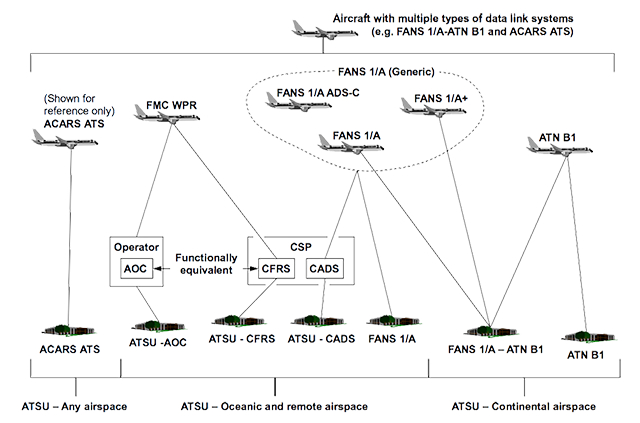
Different ATSU/Aircraft Interoperable Connectivity, from ICAO Doc 10037, figure 1-2.
EU Regulations are written in a serpentine manner, so this might seem disjointed. But follow from start to finish:
This Regulation shall apply to all flights operating as general air traffic in accordance with instrument flight rules within the airspace above FL 285 defined in Parts A and B of Annex I.
Source: EU Commission Regulation No 29/2009, Article I, ¶ 3.
The airspace referred to in [ . . . ] Article 1(3) shall include the airspace above FL 285 within the following Flight Information Regions (FIR) and Upper Flight Information Regions (UIR): Amsterdam FIR, Wien FIR,, Barcelona UIR,, Brindisi UIR,, Brussels UIR,, Canarias UIR,, France UIR,, Hannover UIR,, Lisboa UIR,, London UIR,, Madrid UIR,, Milano UIR,, Rhein UIR,, Roma UIR,, Scottish UIR,, Shannon UIR. — Bratislava FIR,, Bucuresti FIR,, Budapest FIR,, Kobenhavn FIR,, Ljubljana FIR,, Nicosia FIR,, Praha FIR,, Sofia FIR,, Warszawa FIR, Zagreb FIR, Finland UIR south of 61°30′,, Hellas UIR,, Malta UIR,, Riga UIR,, Sweden UIR south of 61°30′,, Tallinn UIR,, Vilnius UIR.
Source: EU Commission Regulation No 29/2009, Annex I, Parts A and B
Requirements for air-ground communications based on ATN and VDL Mode 2.
- Air-ground communications shall be designed to support end-to-end communications and to ensure seamless provision and use of communications services to air-ground applications defined in the ICAO standards specified in points 2 and 3 of Annex III in the airspace referred to in Article 1(3).
- Air-ground communications shall comply with safety and performance requirements of the data link services defined in Annex II.
- Air-ground communications shall be based on a common addressing scheme.
- The transmission and reception of data units between ground and aircraft systems hosting the air-ground applications defined in the ICAO standards specified in points 2 and 3 of Annex III shall be based on communication protocols which comply with the ICAO standards defining the Aeronautical Telecommunication Network referred to in point 4 of Annex III.
- The ground and aircraft communication system characteristics and the transmission and reception of bit frames between ground and aircraft communication systems shall comply with the ICAO standards defining the very high frequency digital link, VDL Mode 2, referred to in point 5 of Annex III.
Source: EU Commission Regulation No 29/2009, Annex IV, Part B
- Chapter 3 — Aeronautical Telecommunication Network, Section 3.5.1.1 ‘Context Management’ (CM) application items (a) and (b) of ICAO Annex 10 — Aeronautical Telecommunications — Volume III, Part I (Digital Data Communication Systems) (Second edition, July 2007, incorporating amendments 70-82).
- Chapter 3 — Aeronautical Telecommunication Network, Section 3.5.2.2 ‘Controller-Pilot Data Link Communications’ (CPDLC) application items (a) and (b) of ICAO Annex 10 — Aeronautical Telecommunications — Volume III, Part I (Digital Data Communication Systems) (Second edition, July 2007, incorporating amendments 70-82).
- Chapter 3 — Aeronautical Telecommunication Network, Sections 3.3, 3.4 and 3.6 of ICAO Annex 10 — Aeronautical Telecommunications — Volume III, Part I (Digital Data Communication Systems) (Second edition, July 2007, incorporating amendments 70-82).
Source: EU Commission Regulation No 29/2009, Annex III, Part B, Points 2, 3, 4
- The ATN shall either use International Organization for Standardization (ISO) communication standards for open systems interconnection (OSI) or use the Internet Society (ISOC) communications standards for the Internet Protocol Suite (IPS).
- ATN/IPS implementation is preferred for ground-ground networks. While ATN/OSI continues to be supported in air-ground networks, particularly when using VDL Mode 2, it is expected that future air-ground implementations will use the ATN/IPS.
Source: ICAO Annex 10, Volume III, Part I, ¶3.3, 3.4, and 3.6 extracted
The ATN B1 data link system relies on the aeronautical telecommunication network (ATN), which is provided and maintained by various CSPs and/or ANSPs. The ATN was developed by ICAO to support the need for ATS communications. The ATN relies only on VHF (VDL M2) to meet the performance required for the intended operations.
Source: ICAO Doc 10037, ¶1.2.1.2
You will need an ATN B1 system to use your CPDLC over domestic European airspace once you've coasted in. FANS 1/A will not work. As of late 2020, you can fly anywhere in Europe without ATN B1, you just can't use data link. Even if you have it, however, you have to get onto a "white list."
The European Data Link Services Mandate aims to restrict noncompliant and non-exempt aircraft to flight below FL 285. Some older aircraft will be exempt. The GI, GII, GIII, GIV, G450, G100, G150, and G200, for example are exempt. EuroControl publishes a "Logon List," known as the "White List" to some, Information about the list, getting on the list, and why it does or does not matter: https://ext.eurocontrol.int/WikiLink/index.php/Logon_List.
4
Operational notes
Confirm assigned route message
- Coming soon to an FMS near you will be a new standard message from Oceanic ATC: “Confirm Assigned Route”.
- If you’ve operated on the ‘half-tracks’ in the NAT recently, you’ll have seen this. So, what’s it all about?
- Short and simple: with the half-tracks, the potential for Nav Errors are now (quite a lot, perhaps) higher than before. Waypoints are that bit more complicated, and 5030N 30W is a little too similar to 50N 30W.
Source: http://flightservicebureau.org/shanwick-new-nat-procedure/
When I first heard this a year and a half ago I dismissed it as something I didn't have to worry about since I operate above the tracks. (We can climb right up to 41,000 feet at any weight.) But lo and behold I have been getting this message routinely.
- So, to prevent you reading back the clearance correctly and then screwing up the route in the FMS, Shanwick (and Gander from 01DEC16) will ask you via datalink “What are you planning to fly?” once you enter the Ocean.
- All you have to do is ack the message, scroll through your route and check it looks OK, and send it back down to them. If it’s the same as your clearance, then that’s that. If not, or you don’t reply, you’ll get an additional telegram from Shanwick.
Source: http://flightservicebureau.org/shanwick-new-nat-procedure/
In Gulfstream PlaneView cockpits you are expected to select "REPORT" and then "SEND" without entering any free text. See:Gulfstream CPDLC Confirm Route.
Flight crew response times
It is said that if they don't hear back from you in sixty seconds, they will consider the communications lost and if a clearance was involved, that clearance is canceled. I've not seen that in writing but the threat is clear: respond within a minute, use "STANDBY" if you must. When dealing with clearances, I usually hit the print button, send the acknowledge, and then read the contents. I figure I can always respond a second time if I have to.
- System performance requirements have been established to support reduced separation standards. Specific latency times have been allocated to the technical performance, and flight crew and controller response times. Regional/State monitoring agencies analyze actual performance to ensure the technical and operational components of the system meet required standards. For example, to support RCP 240 operations, the flight crew is expected to be able to respond to a CPDLC uplink message within one minute.
- For an ATN-B1 aircraft, the flight crew should respond to a CPDLC uplink message within 100 seconds to prevent the CPDLC uplink message from automatically timing out.
- the flight crew is no longer provided with any response prompts for the message;
- the aircraft sends an ERROR message for display to the controller; and
- the aircraft and ground systems close the dialogue.
- When a CPDLC uplink message automatically times out, the flight crew should contact ATC by voice.
- The flight crew should respond to CPDLC messages as soon as practical after they are received. For most messages, the flight crew will have adequate time to read and respond within one minute. However, the flight crew should not be pressured to respond without taking adequate time to fully understand the CPDLC message and to satisfy other higher priority operational demands. If additional time is needed, the flight crew should send a RSPD-3 STANDBY response.
- If a RSPD-3 STANDBY response has been sent, the flight crew should provide a subsequent closure response to the CPDLC message.
Note.— ATN-B1 aircraft use a CPDLC message response timer, which is set at 100 seconds upon receipt of the CPDLC uplink message. If the flight crew has not sent a response within this time:
Note.— For ATN B1 aircraft systems, if the flight crew does not send an operational response within 100 seconds after the RSPD-3 STANDBY was sent, the CPDLC uplink message will time out (refer to paragraph 4.3.2.3).
Note 1.— In the case of a RSPD-3 STANDBY response, the uplink message remains open until the flight crew responds with a RSPD-1 WILCO or RSPD-2 UNABLE. If the closure response is not received within a reasonable period of time, the controller is expected to query the flight crew per paragraph 3.3.1.2.
Note 2.— Transmission times for messages may vary for a number of reasons including the type of transmission media, network loading, or the criteria for transitioning from one media to another (e.g. VHF/Satcom). Operational response times may vary depending on workload and complexity of the instruction or clearance.
Source: ICAO Doc 10037, ¶4.3.2.
FMS waypoint sequencing
You don't have to worry about flying a Strategic Lateral Offset because your FMS will sequence the waypoints even if you are two miles away from the intended course. But if you are further than the tolerance allowed by your FMS, it may not sequence. If that happens, the position report will not be made.

Waypoint sequencing anomaly, from ICAO Doc 10037, figure 4-6.
- The flight crew should ensure that waypoints are sequenced correctly. If an aircraft passes abeam a waypoint by more than the aircraft FMS waypoint sequencing parameter, the flight crew should sequence the waypoints in the FMS, as appropriate.
As shown in [the figure], when an aircraft passes abeam a waypoint in excess of the defined sequencing parameter (refer to , paragraph F.7) for specific aircraft types), the FMS will not sequence the active waypoint. If the flight crew does not sequence the waypoint, incorrect information will be contained in ADS-C reports, CPDLC position reports and FMC waypoint position reports – the next waypoint in these reports will actually be the waypoint that the aircraft has already passed.
Source: ICAO Doc 10037, ¶4.5.1.6
Latency timer
Some manufacturers published misinformation about latency timers that you should take note of it your CPDLC does not include such a device.
The intention of the message latency monitor function is to prevent pilots from acting on a CPDLC uplink message that has been delayed in the network. The most serious of such cases would be the pilot executing a clearance that was no longer valid.
Source: NAT OPS Bulletin 2018-002, ¶2.1
There have been instances with airlines and business jets receiving ATC instructions to climb via CPDLC that did not get delivered to the crew until the following flight. In at least one case the crew executed the climb causing a possible loss of separation.
When the pilot receives the uplink CPDLC message SET MAX UPLINK DELAY VALUE TO [delayed message parameter] SECONDS he/she shall:
a) Send a positive response to ATC as prompted by the avionics (ACCEPT [ROGER]) regardless of whether the aircraft supports the latency monitor.
b) If the aircraft is equipped with a correctly functioning message latency monitor, enter the specified uplink delay into the avionics in accordance with the aircraft procedures. Some avionics will automatically set the delay value in accordance with the uplink message and do not allow for a manual input.
Source: NAT OPS Bulletin 2018-002, ¶2.1
Refer to your aircraft manuals for specific responses. Three particular Gulfstreams provide examples of three possible responses:
- Older G450's without latency timers will respond: "TIMER NOT AVAILABLE"
- GVII will respond "ROGER" and enter the requested time in the "Max Uplink Delay" field on the TSC datalink page
- G280 will respond and set the value automatically, no pilot action required.
Multiple CPDLC connections vs. contracts
You can only have one active CPDLC connection, think of it as your actual air traffic control contact. But you can have two connections, usually the active connection and the "next."
An aircraft can have a maximum of two CPDLC connections established concurrently, each with a different ATSU. Only one CPDLC connection can be active at any given time; any second connection is inactive.
Source: ICAO Doc 10037, ¶1.2.3.1.1.
An ATSU system may request multiple simultaneous ADS contracts to a single aircraft, including one periodic and one event contract, which may be supplemented by any number of demand contracts. Up to five separate ground systems may request ADS contracts with a single aircraft.
Source: ICAO Doc 10037, ¶ 1.2.5.2.2.
Position reporting with CPDLC
When do you need to do a CPDLC position report? It depends! ADS-C might have you covered but some ATSU's want them anyway. The only way to know for sure is to check Appendix B of ICAO Doc 10037. For example, position reports with Gander Oceanic are not required because they don't ask for them in Appendix B:
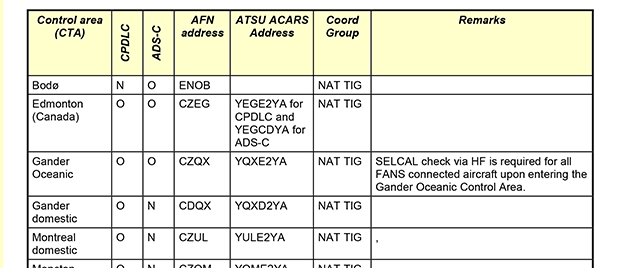
Gander Oceanic Remarks, from ICAO Doc 10037, Appendix B.
Position reports are required with Mauritus because they do ask for them in Appendix B. (CDA is the "Current Data Authority")
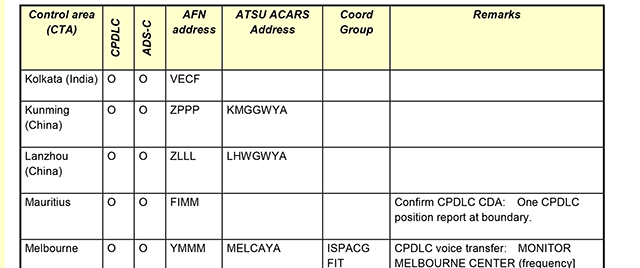
Gander Oceanic Remarks, from ICAO Doc 10037, Appendix B.
When using CPDLC to provide position information, the flight crew should report unnamed waypoints (latitudes/longitudes) using the ICAO format of nn[N/S]nnn[E/W] or, if both degrees and minutes are required, nnnn[N/S]nnnnn[E/W].
Note.— The flight crew and flight operations officers/dispatchers should not use the ARINC 424 format. ARINC 424 describes a 5-character latitude/longitude format for aircraft navigation databases (e.g. 10N40 describes a lat/long of 10N140W). The ATS unit may reject or be unable to process any downlink message containing waypoint names in the ARINC 424 format.
Source: ICAO Doc 10037, ¶4.4.6.1
Oakland OCA/FIR (KZAK) cannot accept position reports containing latitude and longitude (Lat/Long) in the ARINC 424 format, which is limited to five characters (e.g. 40N50). Position reports in the KZAK CPDLC service area containing Lat/Long waypoints will be accepted in complete latitude and longitude format only. Flights unable to send position reports in complete latitude and longitude format must accomplish position reporting via HF voice communications.
Source: Oakland Center Guidance, ¶3
This holds true everywhere in the world. Air Traffic Control does not understand what you mean by "40N50" even if your FMS does. In that case, 40N050W would be called for.
Position reporting in a non-ADS-C environment
- When ADS-C is not available, the flight crew should conduct position reporting by voice or CPDLC. When using CPDLC, the flight crew should send RTED-5 POSITION REPORT (position report) whenever an ATC waypoint is sequenced, (or passed abeam when offset flight is in progress).
- When using CPDLC for position reporting, the flight crew should send position reports only at compulsory reporting points and ensure that the position and next position information applies to compulsory reporting points, unless requested otherwise by ATC. The ensuing significant point after the next position may be either a compulsory or non-compulsory reporting point (refer AIREP form ICAO Doc 4444, Appendix 1).
Source: ICAO Doc 10037, ¶4.4.6.2
Position reporting in an ADS-C environment
- If required by regional supplementary procedures or AIP (or other appropriate publication), the flight crew should provide a CPDLC position report when either of the following events occurs:
- an initial CPDLC connection is established; or
- the CPDLC connection transfer has been completed (i.e. at the associated boundary entry position).
Note.— In an ADS-C environment, the flight crew should not provide position reports or revised waypoint estimates by CPDLC or voice, unless otherwise instructed or under conditions in certain airspace as stipulated in AIP (or other appropriate publication)
Note.— Some ANSPs require a single CPDLC position report, even when in an ADS-C environment, to provide the controlling ATS unit confirmation that it is the CDA and the only ATS unit able to communicate with the aircraft via CPDLC (refer to Appendix B).
Source: ICAO Doc 10037, ¶4.4.6.3
In general you should not provide position reports or revised waypoint estimates by CPDLC or voice unless you see something that tells you to do so. Append B can be misleading. The subject is only brought up in the North Atlantic region where you are explicitly told "For ADS-C flights, the flight crew should not submit position reports via voice to reduce frequency congestion, unless requested by aeronautical radio operator." Makes sense, but don't let that talk you into thinking now you need to do so in other regions because the same phrase is missing.
- The flight crew should include only ATC waypoints in cleared segments of the aircraft active flight plan. However, when an ATC clearance eliminates a waypoint, it is permissible to retain and report the point abeam of that waypoint since this ensures retention of meteorological data associated with the eliminated waypoint.
- The flight crew should maintain the active route in the aircraft system to be the same as the ATC cleared route of flight.
- When reporting by ADS-C only, the flight crew should include ATC waypoints in the aircraft active flight plan even if they are not compulsory reporting points.
Note.— If the flight crew inserts non-ATC waypoints (e.g. mid-points) into the aircraft active flight plan and activates the change, the aircraft system may trigger an ADS-C waypoint change event report at the non-ATC waypoint, or include information about the non-ATC waypoint in the predicted route group, as well as the intermediate and fixed projected intent groups. As a result, the ADS-C report will include information about the non-ATC waypoint, which is not expected by the ATC ground system.
Note.— If the flight crew activates a non-ATC cleared route into the aircraft system, the ADS-C reports will include information that will indicate the aircraft is flying a route that is deviating from the cleared route.
Source: ICAO Doc 10037, ¶4.4.6.3
Testing your datalink
If you have an ARINCDirect account, simply log on to "ARDC" or "ARDD" and wait. It should log you in for five minutes, just as if you were oceanic.
5
Weather deviation
If you need to deviate for weather while using CPDLC, it pays to know Chapter 4 of ICAO Doc 10037. Be careful you ask for a weather deviation versus an offset.
General

Offset and weather deviation, from ICAO Doc 10037, Figure 4-2.
- The flight crew may use CPDLC to request a weather deviation clearance or an offset clearance. The difference between a weather deviation and an offset are portrayed in [the figure].
- A weather deviation clearance authorizes the flight crew to deviate up to the specified distance at their discretion in the specified direction from the route in the flight plan.
- An offset clearance authorizes the flight crew to operate at the specified distance in the specified direction from the route in the flight plan. A clearance is required to deviate from this offset route.
- Flight crews should use the correct message element when requesting an off-route clearance.
Note.— CPDLC offers timely coordination of weather deviation clearances. However, the flight crew may deviate due to weather under the provisions of ICAO Doc 4444, paragraph 15.2.3. The extent to which weather deviations are conducted may be a consideration when applying reduced separations.
Note.— The difference between a weather deviation and an offset affects how ATC separate aircraft.
Source: ICAO Doc 10037 ¶4.4.5.1
You have to stay on your offset course precisely; you can "meander" as necessary up to your cleared distance when cleared for a weather deviation.
Weather Deviation Requests and Offsets
- When requesting a weather deviation or offset clearance, the flight crew should specify the distance off route with respect to the cleared route of the aircraft. If the flight crew has received a off-route clearance and then requests and receives a subsequent off-route clearance, the new clearance supersedes the previous clearance (i.e. only the most recent clearance is valid).
- Example 1: As shown in Figure 4-3, the flight crew requests a weather deviation clearance to operate up to 20NM left of route. The controller issues the appropriate clearance.
- Example 2: As shown in Figure 4-4, the flight crew is operating on a weather deviation clearance up to 20 NM left of route and then requests another weather deviation clearance to operate up to a further 30NM left of route. They specify the deviation distance in the clearance request based on the cleared route rather in relation to the current weather deviation clearance. The controller issues the appropriate clearance.
- Example 3: As shown in Figure 5-6, the aircraft then requests a weather deviation clearance to operate 30NM right of route. The controller issues the appropriate clearance. The flight crew expeditiously navigates from one side of route to the other in accordance with the above clearance.

Weather deviation clearance up to 20 nm, from ICAO Doc 10037l, Figure 4-3.

Subsequent weather deviation up to 20nm left, from ICAO Doc 10037, Figure 4-4.
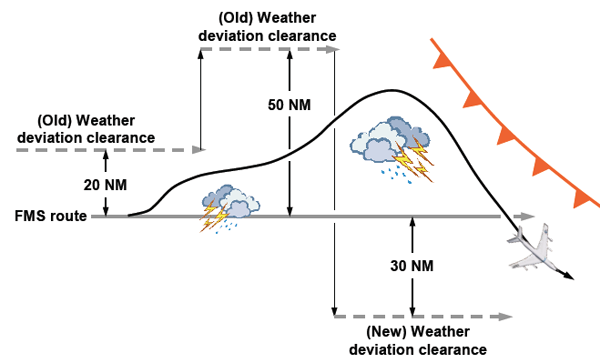
Subsequent weather deviation up to 30nm right, from ICAO Doc 10037, Figure 4-5.
Note.— The ATSU applies the appropriate separation standards during the maneuvers.
Source: ICAO Doc 10037 ¶4.4.5.2
Deviations Either Side of Route
When requesting a deviation on either side of route, the flight crew should request a weather deviation left and right of route using LATD-2 REQUEST WEATHER DEVIATION UP TO (lateral deviation) OF ROUTE.
Source: ICAO Doc 10037 ¶4.4.5.3.1
Reporting Back on Route
When the flight crew no longer needs the deviation clearance and is back on the cleared route, the flight crew should send a LATD-4 BACK ON ROUTE report.
- if during the weather deviation, the flight crew receives a clearance to proceed direct to a waypoint – and the flight crew responds to the clearance with RSPD-1 WILCO – the aircraft is considered to be on the cleared route. Therefore, the flight crew should send a LATD-4 BACK ON ROUTE report after they execute the “direct to” clearance; and
- if the aircraft is off route during a weather deviation clearance and proceeding direct to a waypoint on the cleared route, the flight crew should send a LATD-4 BACK ON ROUTE report after the aircraft has sequenced the waypoint on the cleared route.
Note.— If a LATD-4 BACK ON ROUTE report is received while the aircraft is still off route, the incorrect information provided to ATC may affect the separation standards in use. Alternatively, the flight crew may consider requesting a clearance direct to the waypoint – on receipt of the uplink clearance, the procedure specified in item a) above applies.
Source: ICAO Doc 10037, ¶4.4.5.4.1
6
Where to find regional CPDLC information
If you've taken a formal class in CPDLC you will have been told all about the ICAO Gold Manual and how to find out what your CPDLC and ADS-C obligations are anywhere in the world. You really should have the manual but if you don't, the information is in JeppFD. The problem is that it is buried deep!
The definitive answer is Appendix B of ICAO Doc 10037, also known as the "GOLD" manual because of its name, the Global Operations Data Link manual. In case you don't have that, you can also look on JeppFD where it is buried where you are least likely to find it. It used to take me 10 minutes or more to find it, so I did a series of screen grabs.
Step 1
Let's say you are flying from EGLF to KHPN and want to look up the CPDLC codes. Select the "publications" icon on the left bar:
Step 2
That should bring up some information about the route. Select "Pubs" instead:
Step 3
Here's where I usually go wrong when flying over the Atlantic by selecting Atlantic. Don't do that, there is no En Route Data for the Atlantic there, you need to select Europe if you want Atlantic en route data. In other parts of the world it is more straightforward:
Step 4
Now select the applicable airway manual. This should be obvious, but in the case of the Atlantic, you need to select Europe:
Step 5
Now select the appropriate En Route Data page:
Step 6
Now you should see a "CPDLC Coverage" page. If you don't, try a nearby region instead:
Step 7
Now you should see the coverage map and below that a table with each sector.
References
(Source material)
EU Commission Regulation No 29/2009, 16 January 2009
ICAO Annex 10 - Vol III - Aeronautical Communications, Communications Systems, International Standards and Recommended Practices, Annex 10 to the Convention on International Civil Aviation, Vol III, Second Edition, July 2007
ICAO Doc 4444 - Air Traffic Management, 16th Edition, Procedures for Air Navigation Services, International Civil Aviation Organization, October 2016
ICAO Doc 4444, Amendment 9 to the PANS-ATM, 15 June 2020
ICAO Document 10037 - Global Operational Data Link (GOLD) Manual, First Edition, 2017
NAS Data Communications Guide, FAA, May 15, 2019
NAT OPS Bulletin 2018-02, Latency Monitor, Rev 01, 4 June 2018
